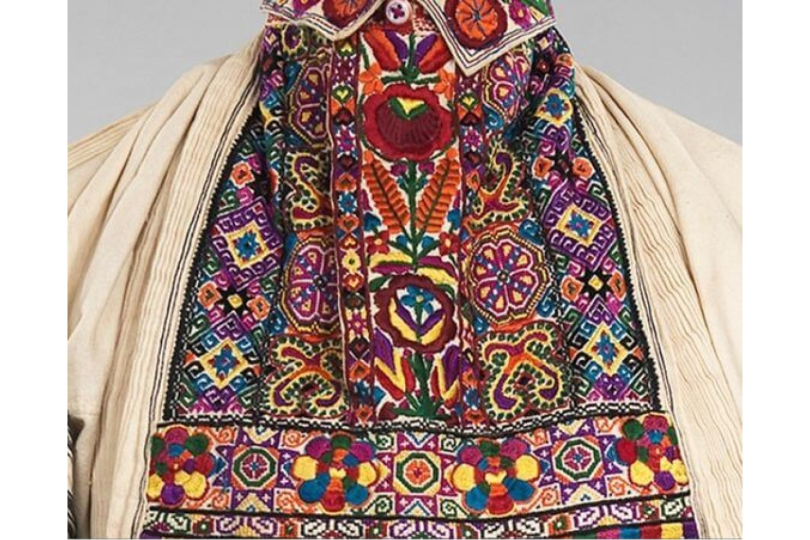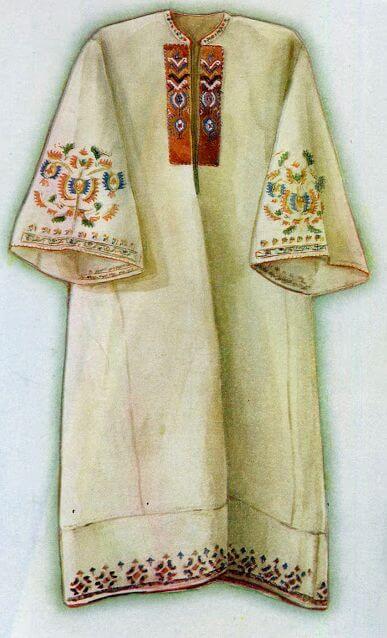Embroidery in the Balkans

Since ancient times beautiful, bright and unique embroidered patterns are created and used in the countries of the Balkan Peninsula. As a rule, each country has its own special approach to the traditional art of embroidery and traditions of wearing embroidered clothing.
Embroidery traditions in Bulgaria
The Bulgarian embroidery is a unique combination of a modern view of traditional art and reverence of ancient needlework techniques. One can see embroidered towels, tablecloths, napkins, clothing and small rugs almost in every house.
Moreover, hospitable hosts will gladly tell you the story of their kin and show the symbols that are characteristic of their family used by their parents and grandparents. If an inquisitive tourist looks more closely, he or she will see stylized images of animals, plants and various elements of inanimate nature.
Bulgarians have an interesting tradition to cover ordinary everyday things with embroidered towels, as if trying to protect them from the evil eye.

Sacred symbols on canvas seem to be a peculiar talisman that attracts health and welfare to the family and keeps off evil forces and their spell at the same time. In many ways, the Bulgarian symbols coincide with the Ukrainian ones. For example, the well-known us “tree of life” is actively used by Bulgarians when they embroider wedding towels, but they call it “world”, “space”, “shaman” and “good”.
As a rule, the Bulgarian “tree of life” is divided into three parts. Each of them has its own sacred meaning.
- The crown of a tree symbolizes the divine world or the area of high stars. In a magical sense, it means people’s hope for the all-powerful God’s assistance.
- The trunk of “the world tree” is an ordinary earthly human life with all its joys and sorrows.
- The roots of this “shaman tree” symbolize the underground world that means something new, mysterious, and so dangerous and threatening.
However, the symbolic “tree of life” is respected by many people, because it is associated with hope that can be neither frightened nor lost.
Another powerful symbol used in Bulgaria is the image of the Sun. As a rule, it is embroidered in the form of a double cross that is called “elbetitsa”. This symbol can be found on various carpets, towels, tablecloths, women’s shirts and dresses, on the sleeves of men’s shirts and bags. This is not surprising. The Sun is the source of heat, life-giving force of the Earth. Bulgarians sincerely believe that their embroidered shirts protect their country from any troubles.
The Czech embroidery

The Czech’s tradition to wear embroidered clothing originates from the national costume and is combined with modernity. There is no woman, especially in the western regions of the Czech Republic, who does not know the techniques of embroidery or does not know how to do it.
A luxury lawn blouse with wide, embroidered and variegated sleeves is an essential attribute of the wardrobe of a true Czech woman. As a rule, it is worn with a bright skirt made of gores. Some of them are embroidered using silk threads or beads. Women’s arsenal of fashionable clothes consists also of traditional festive, chic scarves decorated with lace, silk fringe, bright colours, as well as embroidered patterns.
It is worth noting that men’s clothes keep pace with women’s fashion, when it deals with style and beauty of clothing. Festive jackets, handkerchiefs, shirts and belts are not only decorated with exquisite embroidery, but also adorned with coloured laces or braids.
Regarding the symbolic meaning of the national Czech embroidery, both Ukrainians and the Czech put all their hope for a better future in the patterns and try to protect themselves and their families from the evil one. Embroidered talismans accompany people, give them a life-giving strength and faith in goodness and justice.


Since ancient times beautiful, bright and unique embroidered patterns are created and used in the countries of the Balkan Peninsula. As a rule, each country has its own special approach to the traditional art of embroidery and traditions of wearing embroidered clothing.
Embroidery traditions in Bulgaria
The Bulgarian embroidery is a unique combination of a modern view of traditional art and reverence of ancient needlework techniques. One can see embroidered towels, tablecloths, napkins, clothing and small rugs almost in every house.
Moreover, hospitable hosts will gladly tell you the story of their kin and show the symbols that are characteristic of their family used by their parents and grandparents. If an inquisitive tourist looks more closely, he or she will see stylized images of animals, plants and various elements of inanimate nature.
Bulgarians have an interesting tradition to cover ordinary everyday things with embroidered towels, as if trying to protect them from the evil eye.

Sacred symbols on canvas seem to be a peculiar talisman that attracts health and welfare to the family and keeps off evil forces and their spell at the same time. In many ways, the Bulgarian symbols coincide with the Ukrainian ones. For example, the well-known us “tree of life” is actively used by Bulgarians when they embroider wedding towels, but they call it “world”, “space”, “shaman” and “good”.
As a rule, the Bulgarian “tree of life” is divided into three parts. Each of them has its own sacred meaning.
- The crown of a tree symbolizes the divine world or the area of high stars. In a magical sense, it means people’s hope for the all-powerful God’s assistance.
- The trunk of “the world tree” is an ordinary earthly human life with all its joys and sorrows.
- The roots of this “shaman tree” symbolize the underground world that means something new, mysterious, and so dangerous and threatening.
However, the symbolic “tree of life” is respected by many people, because it is associated with hope that can be neither frightened nor lost.
Another powerful symbol used in Bulgaria is the image of the Sun. As a rule, it is embroidered in the form of a double cross that is called “elbetitsa”. This symbol can be found on various carpets, towels, tablecloths, women’s shirts and dresses, on the sleeves of men’s shirts and bags. This is not surprising. The Sun is the source of heat, life-giving force of the Earth. Bulgarians sincerely believe that their embroidered shirts protect their country from any troubles.
The Czech embroidery

The Czech’s tradition to wear embroidered clothing originates from the national costume and is combined with modernity. There is no woman, especially in the western regions of the Czech Republic, who does not know the techniques of embroidery or does not know how to do it.
A luxury lawn blouse with wide, embroidered and variegated sleeves is an essential attribute of the wardrobe of a true Czech woman. As a rule, it is worn with a bright skirt made of gores. Some of them are embroidered using silk threads or beads. Women’s arsenal of fashionable clothes consists also of traditional festive, chic scarves decorated with lace, silk fringe, bright colours, as well as embroidered patterns.
It is worth noting that men’s clothes keep pace with women’s fashion, when it deals with style and beauty of clothing. Festive jackets, handkerchiefs, shirts and belts are not only decorated with exquisite embroidery, but also adorned with coloured laces or braids.
Regarding the symbolic meaning of the national Czech embroidery, both Ukrainians and the Czech put all their hope for a better future in the patterns and try to protect themselves and their families from the evil one. Embroidered talismans accompany people, give them a life-giving strength and faith in goodness and justice.



Comments
No comment at this time!
Leave your comment